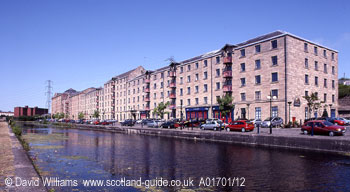The English Navigation Acts of 1660 and 1663 had prohibited Scotland from trading with English colonies and for a while this curtailed the Scots` activities. Undaunted, a huge proportion of the country`s capital was invested in setting up a Scottish colony in Darien in Central America but for numerous reasons this ended in complete disaster in 1701, leading to the loss of one quarter of the country`s liquid assets. Scotland was greatly weakened by what has been called `The Darien Disaster` and the English were blamed for this severe blow to the home economy. Scotland was thus in a poor bargaining position when it discussed possible union with England, but the union took effect in 1707 and one benefit it brought was the ending of discrimination against Scottish traders.
From then on Glasgow`s merchants took full advantage of the new opportunities
that opened up. The city`s location on the west coast gave it a clear
advantage over its London rivals and in 1726 Daniel Defoe noted that London-based
ships faced real dangers especially in time of war, when the [English]
channel is throng`d with privateers, and when the ships wait to go in
fleets for fear of enemies; whereas the Glasgow men are no sooner out
of the Firth of Clyde … and are oftentimes at the capes of Virginia
before the London ships get clear of the channel. The commercial exploits
of the small but very powerful group of Tobacco Lords brought tremendous
wealth to the city. Fortunately, by the time of the American War of Independence
(1776-83) these merchants had already widened their commercial interests
and were thus able to survive the war`s disruption. Some had invested
in Scotland`s manufacturing industry as they could sell the products in
their stores in the Americas; others had put their profits into emergent
industries such as textiles, coal mining and ironworks. They also helped
finance the local canals, notably the Forth
and Clyde Canal (see
picture)
which was planned to link the east and west coasts of the country.
This article is based on the guidebook "The Glasgow Guide".
